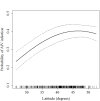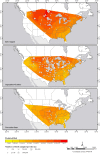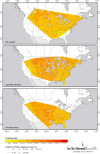Demographic and Spatiotemporal Patterns of Avian Influenza Infection at the Continental Scale, and in Relation to Annual Life Cycle of a Migratory Host
- PMID: 26110538
- PMCID: PMC4481355
- DOI: 10.1371/journal.pone.0130662
Demographic and Spatiotemporal Patterns of Avian Influenza Infection at the Continental Scale, and in Relation to Annual Life Cycle of a Migratory Host
Abstract
Since the spread of highly pathogenic avian influenza (HPAI) H5N1 in the eastern hemisphere, numerous surveillance programs and studies have been undertaken to detect the occurrence, distribution, or spread of avian influenza viruses (AIV) in wild bird populations worldwide. To identify demographic determinants and spatiotemporal patterns of AIV infection in long distance migratory waterfowl in North America, we fitted generalized linear models with binominal distribution to analyze results from 13,574 blue-winged teal (Anas discors, BWTE) sampled in 2007 to 2010 year round during AIV surveillance programs in Canada and the United States. Our analyses revealed that during late summer staging (July-August) and fall migration (September-October), hatch year (HY) birds were more likely to be infected than after hatch year (AHY) birds, however there was no difference between age categories for the remainder of the year (winter, spring migration, and breeding period), likely due to maturing immune systems and newly acquired immunity of HY birds. Probability of infection increased non-linearly with latitude, and was highest in late summer prior to fall migration when densities of birds and the proportion of susceptible HY birds in the population are highest. Birds in the Central and Mississippi flyways were more likely to be infected compared to those in the Atlantic flyway. Seasonal cycles and spatial variation of AIV infection were largely driven by the dynamics of AIV infection in HY birds, which had more prominent cycles and spatial variation in infection compared to AHY birds. Our results demonstrate demographic as well as seasonal, latitudinal and flyway trends across Canada and the US, while illustrating the importance of migratory host life cycle and age in driving cyclical patterns of prevalence.
Conflict of interest statement
Figures






Similar articles
-
ECOLOGICAL DETERMINANTS OF AVIAN INFLUENZA VIRUS, WEST NILE VIRUS, AND AVIAN PARAMYXOVIRUS INFECTION AND ANTIBODY STATUS IN BLUE-WINGED TEAL (ANAS DISCORS) IN THE CANADIAN PRAIRIES.J Wildl Dis. 2016 Jan;52(1):33-46. doi: 10.7589/2013-07-191. Epub 2015 Nov 5. J Wildl Dis. 2016. PMID: 26540179
-
Avian influenza viruses in wild birds in Canada following incursions of highly pathogenic H5N1 virus from Eurasia in 2021-2022.mBio. 2024 Aug 14;15(8):e0320323. doi: 10.1128/mbio.03203-23. Epub 2024 Jul 16. mBio. 2024. PMID: 39012149 Free PMC article.
-
Cross-seasonal patterns of avian influenza virus in breeding and wintering migratory birds: a flyway perspective.Vector Borne Zoonotic Dis. 2012 Mar;12(3):243-53. doi: 10.1089/vbz.2010.0246. Epub 2011 Oct 13. Vector Borne Zoonotic Dis. 2012. PMID: 21995264 Free PMC article.
-
Avian influenza virus: of virus and bird ecology.Vaccine. 2009 Oct 23;27(45):6340-4. doi: 10.1016/j.vaccine.2009.02.082. Epub 2009 Mar 9. Vaccine. 2009. PMID: 19840670 Review.
-
Global patterns of influenza a virus in wild birds.Science. 2006 Apr 21;312(5772):384-8. doi: 10.1126/science.1122438. Science. 2006. PMID: 16627734 Review.
Cited by
-
Could Changes in the Agricultural Landscape of Northeastern China Have Influenced the Long-Distance Transmission of Highly Pathogenic Avian Influenza H5Nx Viruses?Front Vet Sci. 2017 Dec 19;4:225. doi: 10.3389/fvets.2017.00225. eCollection 2017. Front Vet Sci. 2017. PMID: 29312966 Free PMC article.
-
Prevalence and Diversity of Low Pathogenicity Avian Influenza Viruses in Wild Birds in Guatemala, 2010-2013.Avian Dis. 2016 May;60(1 Suppl):359-64. doi: 10.1637/11130-050715-Reg. Avian Dis. 2016. PMID: 27309080 Free PMC article.
-
Comparative micro-epidemiology of pathogenic avian influenza virus outbreaks in a wild bird population.Philos Trans R Soc Lond B Biol Sci. 2019 Jun 24;374(1775):20180259. doi: 10.1098/rstb.2018.0259. Philos Trans R Soc Lond B Biol Sci. 2019. PMID: 31056057 Free PMC article.
-
Molecular Characterization of Non-H5 and Non-H7 Avian Influenza Viruses from Non-Mallard Migratory Waterbirds of the North American Flyways, 2006-2011.Pathogens. 2024 Apr 17;13(4):333. doi: 10.3390/pathogens13040333. Pathogens. 2024. PMID: 38668288 Free PMC article.
-
The ecology of avian influenza viruses in wild dabbling ducks (Anas spp.) in Canada.PLoS One. 2017 May 5;12(5):e0176297. doi: 10.1371/journal.pone.0176297. eCollection 2017. PLoS One. 2017. PMID: 28475626 Free PMC article.
References
-
- Takekawa JY, Prosser DJ, Newman SH, Muzaffar SB, Hill NJ, Yan B, et al. Victims and vectors: highly pathogenic avian influenza H5N1 and the ecology of wild birds. Avian Biol Res. 2010; 3: 51–73.
-
- Koopmans M, Wilbrink B, Conyn M, Natrop G, van der Nat H, Vennema H, et al. Transmission of H7N7 avian influenza A virus to human beings during a large outbreak in commercial poultry farms in the Netherlands. Lancet. 2004; 363: 587–593. - PubMed
Publication types
MeSH terms
Grants and funding
LinkOut - more resources
Full Text Sources
Other Literature Sources
Medical

